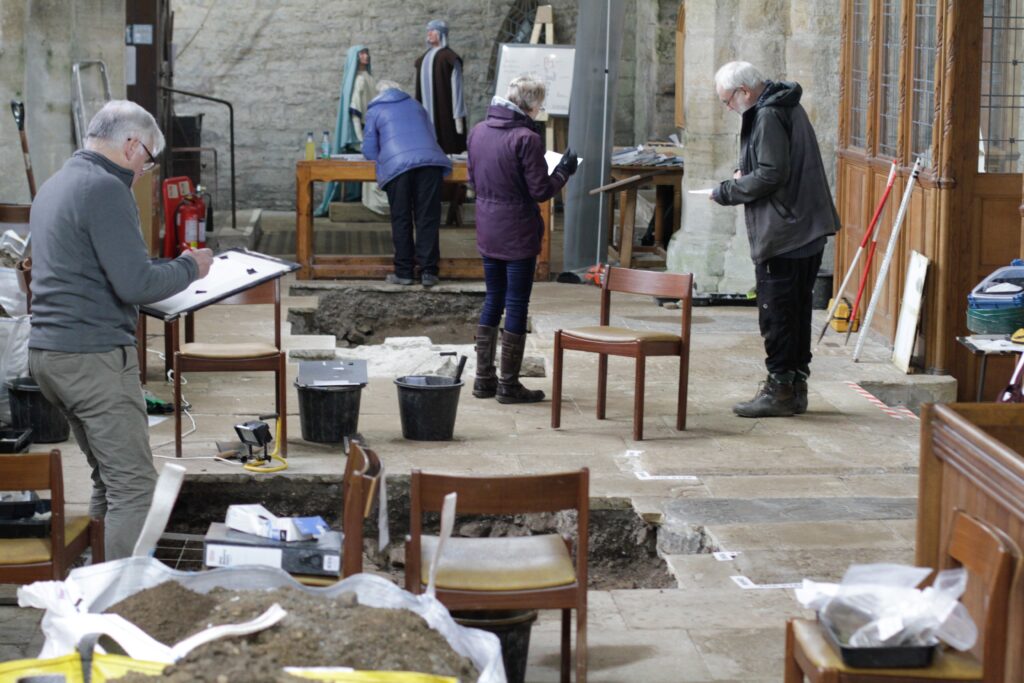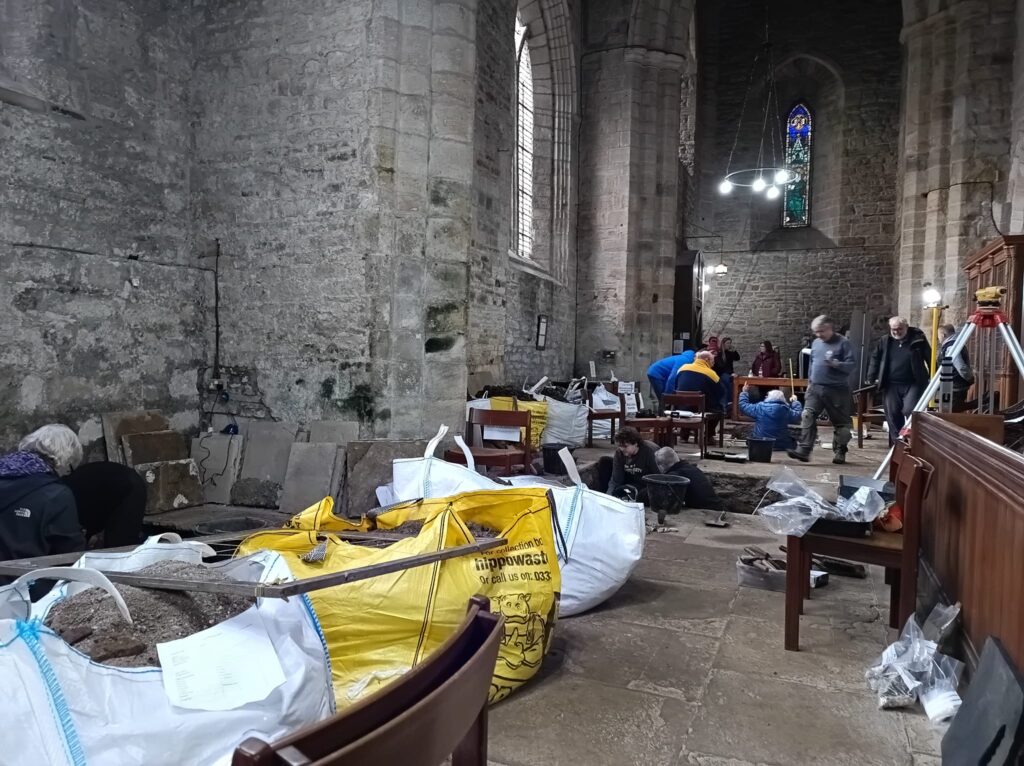Day 10 – Tuesday 7th February 2023
Back to work! The days off were useful for catching up with the paperwork but didn’t do much to relieve the aching muscles – it gets more difficult to climb into and, especially, out of the trenches!
We opened trench 1 outside by the tower on Saturday and found a layer of gravelly material. Today we started carefully trowelling that, but it soon became clear that there was enough depth to the gravel/soil mix to attack it a bit more robustly. This we started to do before lunch and a stony area began to appear in the south-west corner of the trench. Robust trowelling and a bit of careful mattocking allowed most of the gravelly fill to be removed this afternoon. More stone was revealed in the north-east corner and this, with clay, seems to extend along the east side of the trench. We hope that we’re finding evidence of the clerestory that formed an extension on the east side of the tower. Plenty more work to be done here tomorrow.

Work in trench 2 came to a sudden stop because it became obvious that we had found a grave as well as the culverts or drains that we’d already uncovered. It was decided that we would leave this trench now and concentrate on recording it properly with photographs and section drawings. We’ve reached a similar stage in trench 3 – without finding a grave – and the drawing of the sections of the sides of the trench are under way.
In trench 4, Revd Helen carried on cleaning up the potential floor that she found on Saturday and cleaning the edge of the cut she’d found in it. She’s even more convinced now that it is a grave and that it extends beneath the wall, which must have been inadvertantly built across it.
We had another good crowd of volunteers and of visitors today, so there was good work done and lots of conversation and explanations.
Like many ancient buildings, the abbey has stories that it’s hard to verify. It’s common for there to be speculation about secret tunnels (and ghosts) in such buildings and there is a legend that there was a secret tunnel running from the abbey tower to a fort on the river. However, no evidence has been found for that. When we investigated under the stairs at the bottom of the tower, we quickly came to the natural (the undisturbed geology). Any tunnel would have had to have been dug through the natural boulder clay below the original floor – well below the modern one – and probably below the water table so would have been constantly flooded. It may be that the information about the culverts, passed down the years, was distorted and misunderstood. They aren’t as much fun, though!
Day 11 – wednesday 8th February 2023
It was really quite pleasant this morning, working outside in trench 1. It was warmer than in the abbey, the sun was shining and our local friendly robin was hopping around hoping something edible would be turned up. The feature in the north-east corner that began to appear yesterday was cleaned up and is possibly going to be of interest. It’s surrounded by yellowish material that fills about three-quarters of the trench and is clayish in texture. The area of stones in the south-west corner seems to be cut into this yellow material.
It was really cold out there this afternoon because a very chilly wind got up and whistled round the corner of the tower. Nonetheless the cleaned and tidied trench was photographed and planned ready for further investigations.
Trench 2 was also cleaned and tidied so that the sections could be drawn. When the big mysterious wall was cleaned for photographing, it became clear that it was better built than we thought. Rather than being two lines of stone with a core of mortar, it has stones within the centre, too.
Trench 3 is at the planning stage, with sections being drawn today. It’s unlikely that there will be any more digging to do in there. However, in trench 4 we’re checking what some of the flat stones are doing – are they part of a floor or of another culvert? Then there are sections to be drawn in there, too.

Apart from Trench 1, most of the digging is finished and the main work is recording what we’ve found. Be prepared for that if you’re booked to come in the next few days!
Andy and I left a bit early today for a medical appointment, so we missed the very end of the afternoon. However, we’ll be back in the trenches first thing tomorrow.
Day 12 – Thursday 9th February 2023
Well, I’ve been home for more than 2 hours and I’ve still not thawed out!
Thursday is our day for re-grouping and thinking, for planning what comes next, so we only had one volunteer this morning and one this afternoon. Consequently we left trench 1, outside, for the day and will continue with it tomorrow.
Good progress was made at the end of yesterday afternoon and trench 1 was planned at the context it had reached. Today was mostly a matter of recording the various features in trenches 2 and 3 in detail. We can get reasonably warm when working hard, when trowelling, but sitting measuring and drawing isn’t exactly an activity that keeps you warm. It’s not so bad in the morning but sitting in the cold at lunchtime doesn’t help and the chill gradually creeps into the bones. The photos show Rob planning in trench 2 and the wall that Andy and I drew this morning.
This morning we had children from Slaley school looking round and working in groups with local people. We carried on working although Rob did a timeline with the children and we chatted to some of them as they came round the abbey. Many of them showed an interest and we could hear them answering questions sensibly and thoughtfully.

In the afternoon we had a visit from Peter Ryder, an historic buildings expert who has researched various aspects of Blanchland and the abbey several times over the years. He was just as flummoxed as we are with what we’ve found, I think. It was good that he could see what’s been lurking under the floor!
Although the underfloor features aren’t quite what we anticipated and we can work out the sequence of events from the relationships between them, we’re disappointed that the finds are so few and that they don’t help with dating the features.
So what are the more interesting things that we’ve found during the last couple of weeks? Most of the finds have been from the layer of fill beneath the flagstones and have included a couple of clay pipe stems and some bones, probably sheep bones that had been used as pegs to hold stone roof tiles in place.
At the Dissolution of the Monasteries, Henry VIII’s men made a point of removing everything of value from the monastic buildings. They burned the Popish books, having removed the gold and silver clasps and corner pieces.
The base metal pieces they discarded. Similarly they threw away the stained glass but collected the lead that held the windows together. We’ve found a couple of pieces of mediaeval stained glass similar to that found when the chapter house was excavated in the grounds of the Lord Crewe a few years ago. There’s been a small piece of mediaeval Cistercian pot, and some fragments of glazed tile that are so worn the glaze is hard to see. Other than that, artefacts from the monastery are lacking. The monks at Blanchland, for much of the time, were very few and very poor, so there was probably not a great deal for Henry VIII’s men to collect anyway, and certainly nothing for us to find.
Day 14 – Friday 10th February 2023
Well, here we are almost at the end. It’s still freezing in the abbey, especially when sitting on the stone floor in order to draw sections of the trenches
It’s becoming harder to find things for the brilliant volunteers to do. There’s still a little work to do in trench 1. Today we found the water pipe serving the tap in the churchyard! See the photo. That was worthwhile, in a way, because it confirms the accuracy of the geophysics – the pipe is just where the geophys said it should be. There’s something alongside it which is more structural, so we might take a good look at that, while leaving the water pipe well alone.
Trench 4 has produced what we are pretty sure is a mediaeval floor (photo showing it waiting to be planned) although any nice glazed tiles that it might have sported are long gone. It’s probably the floor of the original building.
Much of today’s work has been recording the details of the trenches so that we have all the necessary information for the report. Apart from trench 1, this is what we’ll be doing tomorrow, too. Tomorrow is the last day for volunteers.
The finds have to be sorted and will form part of the final report, along with all the drawings and photographs. The report and all its parts are work for Rob, Andy and me. When will it be ready? When it’s done!
Most of today’s visitors came this afternoon, as usual, but this morning we had children from Whittonstall school (linked with Broomley, I believe – sorry of I’ve got that wrong). Like yesterday’s junior visitors, they were interested and engaged, which made it a pleasure to have them with us. Yesterday we had a visit from a friend from Altogether Archaeology and today a whole bunch of them came to see what we are up to; several members have been among our volunteers, too.
Day 13
Well, here we are almost at the end. It’s still freezing in the abbey, especially when sitting on the stone floor in order to draw sections of the trenches
It’s becoming harder to find things for the brilliant volunteers to do. There’s still a little work to do in trench 1. Today we found the water pipe serving the tap in the churchyard! See the photo. That was worthwhile, in a way, because it confirms the accuracy of the geophysics – the pipe is just where the geophys said it should be. There’s something alongside it which is more structural, so we might take a good look at that, while leaving the water pipe well alone.

Trench 4 has produced what we are pretty sure is a mediaeval floor (photo showing it waiting to be planned) although any nice glazed tiles that it might have sported are long gone. It’s probably the floor of the original building.

Much of today’s work has been recording the details of the trenches so that we have all the necessary information for the report. Apart from trench 1, this is what we’ll be doing tomorrow, too. Tomorrow is the last day for volunteers.
The finds have to be sorted and will form part of the final report, along with all the drawings and photographs. The report and all its parts are work for Rob, Andy and me. When will it be ready? When it’s done!
Most of today’s visitors came this afternoon, as usual, but this morning we had children from Whittonstall school (linked with Broomley, I believe – sorry of I’ve got that wrong). Like yesterday’s junior visitors, they were interested and engaged, which made it a pleasure to have them with us. Yesterday we had a visit from a friend from Altogether Archaeology and today a whole bunch of them came to see what we are up to; several members have been among our volunteers, too.
Day 14 – Saturday 11th February 2023
Today was the last day of the dig for volunteers, although Rob, Andy and I will be going back to the abbey to do the last minute jobs and tidy up. The abbey will be open, we hope, Tuesday to Saturday next week from 1 to 4pm so that people who haven’t had a chance to see what we’ve been doing can visit – or revisit to see what has changed since they last came.
Most of our gallant volunteers worked in the chill of trench 1 today, trying to find out what the features in the trench mean. They made some progress, but it’s still difficult to understand quite what we’ve uncovered. We’ll take another look next week and try to solve the mystery – a short break might allow us to see it with new eyes.

The recording of the plans and sections is almost finished, too, thanks to one of our volunteers who drew plans of trench 4 and its mediaeval floor.
Gianluca and Vicky returned today to complete their laser survey of the abbey, working on the outside of the building. They enjoyed a tour of the excavations as, when they surveyed the inside we hadn’t started the dig.
This afternoon one of the youngsters from Slaley school brought his mum. She was quite pleased that he was kept occupied in trench 1 for several hours! We had lots of visitors, especially in the afternoon. On a couple of occasions there were crowds gathered round listening to Rob explaining everything, although our volunteer guides, Andy and I all welcomed people to look round.

The volunteer diggers that we’ve had over the last 3 weeks have been amazing and many of them have been brave enough to come back, sometimes more than once! They’ve worked really hard and helped us make rapid progress. What’s more, they’ve been cheerful and friendly and made the atmosphere in the abbey warm with goodwill even if the temperature has been freezing. Thank you!
Thank you, too, to the volunteer guides for the good work you’ve done in caring for the visitors. Although we’ve enjoyed talking to the folk looking round we wouldn’t have got any work done if the guides hadn’t been there.
Thanks also to the The White Monk Tearoom for the use of their “facilities” and the opportunity to warm ourselves. It made a real difference to our comfort!
Finally, thanks to everyone else for flasks of hot water, cake, the loan of lights and other equipment, admin, taking an interest and all the other things that have made our task easier.




